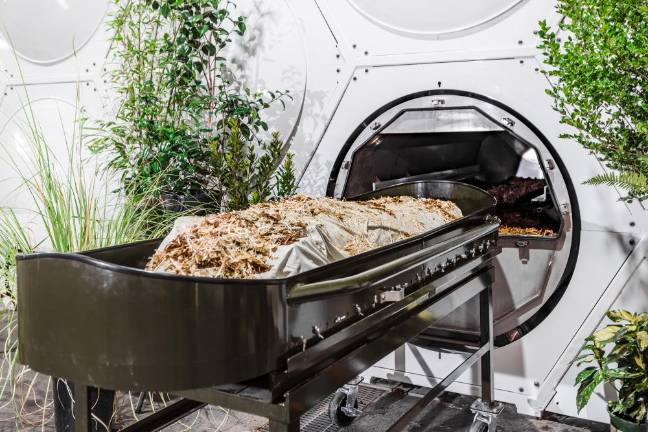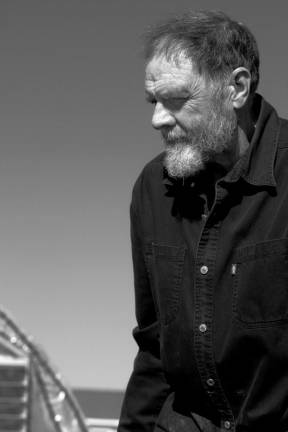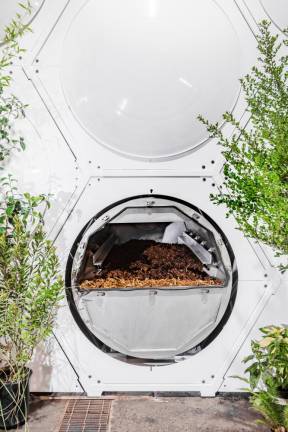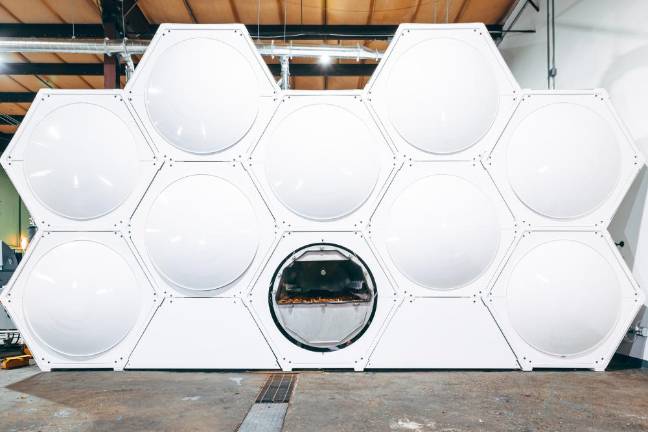Dissolving, composting: the new frontier in eco-friendly endings
A retired organic farmer contemplates the ultimate act of giving back




When we die, we leave behind flesh and bones and assorted entrails that have to be dealt with. This is not a subject many people want to dwell on. To my mind, though, there is something reassuring about the circle of life — the endless movement of energy through the bodies of living things from one generation to the next. Regardless of one’s views on mortality, those of us who live long enough will likely, at some point, need to make choices concerning the disposition of our bodily remains and/or those of our loved ones.One increasingly mainstream option is “green burial” or “natural burial,” which is the simple interment of a cadaver in the ground, usually wrapped in a biodegradable cloth. No formaldehyde, no coffin, no concrete vault. A growing number of cemeteries have set aside green burial sections that are less intensively maintained. Preserves of semi-forested land are also being used for this type of burial.Now the green death care movement is writing its next chapter with a pair of pioneering new methods: aquamation and natural organic reduction. Both are in their infancy in the United States, more widely accessible on the West Coast than in the Northeast.
Aquamation: cremation by water
The revered South African theologian and human rights activist Desmond Tutu died in December at age 90, specifying before his death that his body undergo aquamation. Tutu was a champion of the environment and advocate of oil company boycotts who spoke urgently of climate change as among the “greatest moral challenges of our time.”
In this end-of-life process, the body is placed in a stainless steel chamber filled with 95 percent water and 5 percent alkaline fluid. Heat and pressure are applied, and the chamber rocked gently from side to side. Depending on the machine, the aquamation process can take from two hours to half a day, after which the body’s flesh and soft tissue are dissolved in the surrounding fluid. The bones, however, remain. These are usually ground into a powder, treated much the same way as bones left after cremation. The remaining alkaline fluid is non-toxic and can be flushed into a municipal drainage system or applied to open land. In the soil it does have nutritional value, unlike the remains left after cremation, which are quite sterile.
Also called alkaline hydrolysis, aquamation uses about a tenth the energy of flame cremation, according to Bio-Response Solutions, an Indiana-based manufacturer of aquamation chambers (including the one in which Tutu’s body was aquamated). Veterinarians nationwide have been using aquamation, on a smaller scale, to dispose of the bodies of cats, dogs and other pets for many years.
Now the process is legal for humans – though not necessarily available – in about 21 states, a number that fluctuates as states change, and in some cases repeal, statutes. New York, New Jersey and Pennsylvania are considering aquamation regulations. The process is legal and available in Maine. In Vermont, it’s been legal since 2014 but no funeral home in the state offers it.Because aquamation equipment is expensive ($200,000 to $400,000 per chamber), many funeral homes are reluctant to make the investment. That reluctance often has deep roots. The multi-billion-dollar funeral industry, much of which is owned and controlled by a handful of mega-companies, has a strong vested interest in protecting its turf. Alternatives like aquamation and natural organic reduction could seriously cut into its business. In Indiana, a state representative who owns two casket manufacturing companies spoke against the bill to legalize alkaline hydrolysis, and succeeded in quashing it. The Catholic church has also been a staunch opponent of aquamation, on the grounds that dissolving human remains into a liquid fails to respect the dignity of the deceased, and has voiced similar objections to natural organic reduction.
The sole facility in Maine that currently offers human aquamation is the family-run Riposta Funeral Home in Belfast, where it is listed as Natural Green Cremation for $1,500. Conventional modern burial can, by contrast, exceed $10,000, between the coffin, concrete vault, plot of land, tombstone and undertaking services. Riposta Funeral Home has performed hundreds of aquamations, some on cadavers transported from neighboring states, including New York, New Jersey and Massachusetts, said Andrew Riposta, son of founder Mark Riposta.
Natural organic reduction: human composting
As a longtime organic farmer, I am a fan of composting — usually the recycling of vegetative material and animal manure into a rich organic soil amendment. It is, however, also possible to compost dead humans. No, we’re not doing this on our farm yet. But elsewhere it is happening.
Natural organic reduction is legal in three states: Washington, Oregon and Colorado. The body is placed in an eight-foot steel vessel containing woodchips, straw and alfalfa. After 30 days, during which moisture, oxygen, heat, and acidity levels are monitored and controlled, the contents of the vessel, including the cadaver, are transformed into compost. The bulk of the work is done by beneficial microbes. The end product, about a cubic yard of soil-like material, is then transferred to curing bins where it is held for another few weeks and tested for toxins. Tooth fillings, pacemakers, metallic body parts and the like are screened out. The healthy compost that remains can then be returned to relatives of the deceased or spread on forested land.
Natural organic reduction is the brainchild of Katrina Spade, founder of Recompose in Kent, WA. Recompose transformed its first human bodies into compost in 2020, a few months after Governor Jay Inslee of that state signed a human composting bill into law. The company now has 10 composting vessels. Still, they are overbooked with a growing wait list, fielding inquiries from as far as New York.
Human composting may be on the verge of making its way east. New York State Assembly member Amy Paulin (D-Westchester) and state Senator Leroy Comrie (D-Queens) have co-sponsored a bill to legalize natural organic reduction, as part of the state’s efforts to eliminate carbon emissions by 2050.
The environmental toll of the status quo
From an environmental perspective, cremation and modern burial are becoming increasingly problematic. Burial, especially when it occurs in a “forever” plot, takes up space. These days, space is something we are running alarmingly low on, given our ever increasing human population – a harsh fact laid bare by the nightmarish scenes of the bodies of Covid victims piling up outside hospitals and funeral homes in refrigerated trucks and trailers.
In addition to being a space guzzler, modern burial devours resources. The coffin industry relies heavily on wood, requiring the felling of trees on millions of acres of forested land annually. Copper, bronze and steel are also used in substantial quantities. Reinforced concrete vaults, in which coffins are usually placed, consume more than 1.5 million tons of concrete each year. Cemetery maintenance requires copious amounts of water, fertilizer, pesticide, and fuel for mowing and trimming grass.
Then there’s the rather toxic brew of embalming fluids used in modern burial. The purpose of these fluids (primarily formaldehyde, but also phenol, methanol and glycerin), which are injected into the carotid artery, is to keep us looking somewhat alive even when we are dead. Depending on the skill of the embalmer, they can be moderately effective in this regard but, after the body is buried, these chemicals gradually leach into the soil and ground water, creating potential problems for those of us who are still alive. If you live near a cemetery and depend on a well for drinking water, it might be wise to have it tested for chemical and microbial contamination. Morticians who work with formaldehyde have been found to have higher rates of leukemia and certain rare cancers.
These days more than half of Americans are cremated when they die. Cremation tends to cost less than conventional burial, but comes with serious environmental liabilities. To reduce a human body to its skeletal form, the temperature inside a crematorium must remain around 1,600° Fahrenheit for more than two hours. This intense heat over a prolonged period requires the equivalent of around 28 gallons of gasoline and emits an estimated 500 pounds of carbon. These numbers become alarming when you consider that somewhere between 1.5 and 2 million Americans will be cremated in the current year.
For those who care about the environmentally threatened planet we inhabit and the wonderful diversity of life it supports, aquamation and natural organic reduction may be fitting alternatives to modern burial and cremation. To me, there is something transcendent and affirmative in returning our bodily remains, in healthy form, to the living earth that nourishes us.